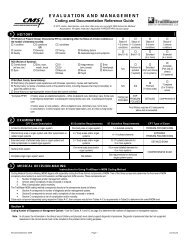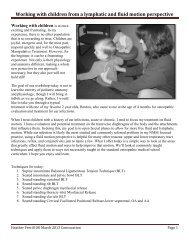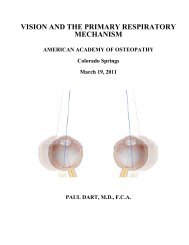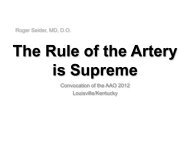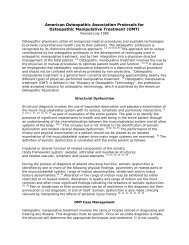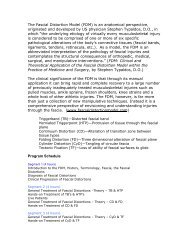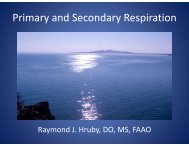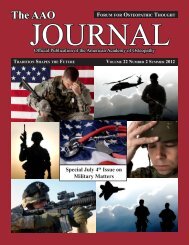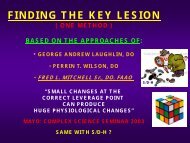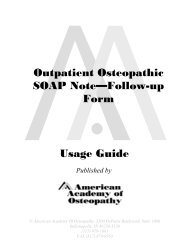THE LIVING MATRIX - American Academy of Osteopathy
THE LIVING MATRIX - American Academy of Osteopathy
THE LIVING MATRIX - American Academy of Osteopathy
Create successful ePaper yourself
Turn your PDF publications into a flip-book with our unique Google optimized e-Paper software.
<strong>THE</strong> <strong>LIVING</strong> <strong>MATRIX</strong><br />
R. Paul Lee, DO, FAAO, FCA<br />
Orlando, FL<br />
March 23, 2013
What I want to say today<br />
Describe a model for PRM in the<br />
extracellular matrix.<br />
Discuss the role <strong>of</strong> cells, water and<br />
connective tissue.
Connective Tissue<br />
Bones<br />
Joints<br />
Ligaments<br />
Muscles
Connective Tissue<br />
Fascia<br />
Extracellular Matrix<br />
Cytoskeleton
Extracellular Matrix<br />
• Also known as the Ground Substance or<br />
“Matrix”<br />
• Additional info:<br />
1. Lee, RP (2001). The primary respiratory<br />
mechanism beyond the craniospinal axis.<br />
AAOJ, 11(1):24-34.<br />
2. Lee, RP (2005). Interface: Mechanisms <strong>of</strong><br />
Spirit in <strong>Osteopathy</strong>. Stillness Press.
Histology <strong>of</strong> the Matrix<br />
• Enmeshed in matrix:<br />
– Cells<br />
– Capillaries<br />
– Nerves<br />
– Lymphatics
Histology <strong>of</strong> Matrix<br />
• Functions:<br />
– Delivery <strong>of</strong> nutrients.<br />
– Elimination <strong>of</strong> waste.<br />
– Communication among cells.<br />
– Intimate connection <strong>of</strong> all parts <strong>of</strong> the body.<br />
• Fibroblasts:<br />
– Manufacture matrix components.<br />
– Syncytium
Fibroblasts form<br />
syncytium
Matrix Behaves as a Primitive<br />
Nervous System
Matrix mediates functions for cells.<br />
• Nerves terminate in the matrix not on the<br />
cells.<br />
• Vessels excrete their nutrients into the<br />
matrix not into the cells.<br />
• Lymph originates in the fluid <strong>of</strong> the<br />
extracellular matrix.
Matrix Displays Immune Function<br />
• Mast cells reside in the matrix.<br />
• Macrophages, PMNs, and lymphocytes pass<br />
through the matrix.<br />
• Detoxification processes occur in the matrix.<br />
• Acidic products <strong>of</strong> cellular metabolism are<br />
neutralized in the alkaline matrix.
PROTEOGLYCAN<br />
1.Hyaluronan<br />
2.Proteoglycan<br />
a. Core protein<br />
b. Keratin sulfate<br />
c. Chondroitin<br />
sulfate
GAGs and Proteoglycans bind water<br />
forming a gel.
Gabarel and Roques’ theory <strong>of</strong> the<br />
generation <strong>of</strong> the PRM<br />
• Based on the amount <strong>of</strong> free water vs. bound<br />
water in the extracellular matrix.<br />
• When matrix is depolymerized by increased<br />
concentration <strong>of</strong> electrolytes, water is freed.<br />
• Concentration <strong>of</strong> electrolytes decreases with<br />
free- and increases with bound-water, creating<br />
oscillating feedback loop.
Phase Transitions<br />
• Most familiar – melting or freezing water.<br />
• Definition: a change in shape, size,<br />
permeability, hardness, chemical and/or<br />
electrical activity.<br />
• Stimuli: change in pH, temperature, salt,<br />
electric field, mechanical stress.
Phase Transitions in Matrix<br />
[Gabarel & Roques]<br />
• Gels are prone to phase transitions.<br />
• A change in viscosity (the state <strong>of</strong> free or<br />
bound water).
“Injury Potential”<br />
[Nordenström]<br />
• A measurable change in the electric<br />
potential <strong>of</strong> the tissue when injured.
“Energy Sink”<br />
• Robert Fulford, DO used this term to refer<br />
to areas <strong>of</strong> tissue that are palpably altered<br />
from trauma.<br />
• A palpatory confirmation <strong>of</strong> an injury<br />
potential, that is, a palpable mechanical<br />
change that corresponds with an electric<br />
change.
Electric Potentials<br />
in Organs<br />
[Nordenström]
Fluctuation <strong>of</strong> Polarity in Tissues<br />
[Nordenström]<br />
Fluctuation <strong>of</strong> polarity is created when an<br />
a. injury potential or<br />
b. physiological polarization<br />
is accompanied by an opposite reaction to<br />
balance the polarity.<br />
As entropy increases in this process,<br />
fluctuation is established.
Characteristics <strong>of</strong> Fluctuations<br />
[Nordenström]<br />
• Fluctuations occur in the vascular and interstitial<br />
fluids.<br />
• Healing results from ebb and flow <strong>of</strong> ions.<br />
• Fluctuations occur in injured and normal tissue<br />
and in morphogenesis.<br />
• Oxidation/Reduction reactions occur in the fluids<br />
next to fibrous membranes.
Fluids are Good Conductors<br />
[Nordenström]<br />
Electrical reactions from flows <strong>of</strong> ions and<br />
electrons occur readily in water because <strong>of</strong><br />
a. The characteristics <strong>of</strong> water itself.<br />
b. Dissolved electrolytes.<br />
c. Dissolved proteins.
“Ionars”<br />
[Nordenström]<br />
• Ionars are groups <strong>of</strong> ions.<br />
• Collect in the extracellular fluid because <strong>of</strong><br />
metabolic activities and local differences in<br />
a. capillary bed circulation<br />
b. matrix properties<br />
c. ionic size and mobility
“Ionars”<br />
[Nordenström]<br />
• Represent an electromotive force.<br />
• Participate in the fluctuation <strong>of</strong> charge.<br />
• Responsible for actual structural modifications.<br />
• Associated with movement <strong>of</strong> water.
Pischinger<br />
• Fundamental importance <strong>of</strong> the ground<br />
substance (matrix) in the extracellular<br />
space.<br />
• All cells, nerves, and vessels are imbedded<br />
in and functionally connected by matrix.
Matrix is Piezoelectric<br />
[Pischinger]<br />
• Vibrations stimulate electric activity and<br />
electric activity stimulates vibrations.<br />
• Vibrations (mechanical stimuli) travel at<br />
the speed <strong>of</strong> sound through the tissues.<br />
• Electric stimuli travel at the speed <strong>of</strong> light.
The matrix provides the milieu for<br />
the healthy function <strong>of</strong> cells.<br />
[Pischinger]<br />
• Disturbances in the matrix are the starting<br />
point <strong>of</strong> many diseases.<br />
• The matrix is involved in every disease<br />
and in its healing.<br />
• Fundamentally, the same concept as Dr.<br />
Still proposed.
Pischinger Expanded Virchow’s<br />
Hypothesis<br />
• Virchow declared that the cell is the basic unit <strong>of</strong><br />
life.<br />
• Pischinger included with the cell, the connective<br />
tissue (matrix), capillary bed, and lymphatics as<br />
the basic unit <strong>of</strong> life.<br />
• Dr. Still proposed same concept with his idea <strong>of</strong><br />
“biogen.”
Szent Gyorgyi<br />
Fibers and<br />
proteins are<br />
semiconductors
Shininess <strong>of</strong> connective tissue<br />
[Oschman]<br />
• Shininess <strong>of</strong> connective tissue at surgery<br />
indicates the health <strong>of</strong> the tissue and the<br />
amount <strong>of</strong> electrons in the matrix.<br />
• The amount <strong>of</strong> electrons correlates with<br />
the alkalinity <strong>of</strong> the tissue and its ability to<br />
quench acidic toxins.
Matrix is a storage compartment<br />
[Pischinger]<br />
• The matrix holds toxins until they can be<br />
disposed <strong>of</strong>.<br />
• At night when the body is at rest, the<br />
lymph and blood clear the matrix and<br />
deliver toxins to the liver for disposal.
Matrix is an open system<br />
[Pischinger]<br />
• Open systems are subject to energetic and<br />
material influences from outside.<br />
• Parenchymal cells, immune cells, nerve cells,<br />
and blood capillaries all influence the matrix<br />
driving an oscillatory mechanism.<br />
• GAGs and proteoglycans are changed in specific<br />
ways by all these influences.
Matrix and Cell Membrane<br />
[Pischinger]
Glycocalyx and Cytoskeleton<br />
[Pischinger]<br />
• Glycocalyx transfers<br />
input from the<br />
extracellular matrix<br />
into the mechanisms<br />
<strong>of</strong> the cell even down<br />
to the genes.<br />
• Matrix influences cell<br />
growth, cell division,<br />
and cell movement.
Water carries information<br />
[Pischinger]
“Fluids, Matter in Motion”<br />
• Lee (2002), Fluids, Matter in Motion,<br />
Cranial Letter, volumes 55 and 56.
Biodynamics<br />
[Pischinger]<br />
• Biodynamics: Transformation between<br />
energy and mass.<br />
• A clear example <strong>of</strong> biodynamics is the<br />
energy flow between the sugar<br />
biopolymers (GAGs and proteoglycans)<br />
and water in the matrix.
Biodynamics<br />
[Pischinger]<br />
• Spontaneously generating patterns that<br />
spread themselves through the matrix are<br />
an expression <strong>of</strong> life-retaining interactions<br />
between matter and energy.
Etheric Body<br />
[Pischinger]<br />
• Matrix is physical aspect <strong>of</strong> etheric body, the<br />
energetic aspect <strong>of</strong> which provides pattern to<br />
form physical body.<br />
• The matrix is the interface <strong>of</strong> the material and<br />
etheric bodies – biodynamics.<br />
• Dr. Fulford emphasized working with the etheric<br />
body.
Summary <strong>of</strong> three books<br />
• Matrix is where the action is.<br />
• It is both changeable and stable.<br />
• Influences from cells, nerves, vessels and lymph all<br />
mingle.<br />
• Matrix gives direction to cell’s functioning.<br />
• Redox reactions occur routinely along fibrous and<br />
cellular membranes in the fluids.
Summary <strong>of</strong> books<br />
• Matrix is naturally a gel blocking the passage <strong>of</strong><br />
substances unless its viscosity is reduced.<br />
• Alterations <strong>of</strong> viscosity occur from changes in<br />
pH, temperature, electric fields, mechanical<br />
stress, and electrolyte concentration.<br />
• Matrix is characterized by varying viscosity,<br />
changing charges, and fluxes <strong>of</strong> fluids and ions.
Summary <strong>of</strong> books<br />
• Information is carried in the matrix<br />
by the structure <strong>of</strong> water<br />
by patterns <strong>of</strong> sugar polymers<br />
by patterns <strong>of</strong> dissolved substances.<br />
• Information is transmitted instantaneously<br />
• Matrix integrates entire system.
Summary<br />
• Injury to tissue changes the electro-mechanical<br />
quality <strong>of</strong> the matrix.<br />
• Flows <strong>of</strong> ions and water are the means by which<br />
healing occurs.<br />
• Biodynamic transformations between energy and<br />
matter occur with changing patterns in sugar<br />
polymers and water.
Summary<br />
• Matrix represents the etheric body in the<br />
physical form.
Matrix is Osteopathic<br />
• Matrix expresses unity (unifies whole body and<br />
represents the etheric body).<br />
• Its structure and function are reciprocally interrelated.<br />
(As viscosity changes so does function.)<br />
• Its substance contains all the necessary resources for<br />
maintenance and healing. (Acts as a nervous, immune,<br />
detox, and storage system. Delivers information from<br />
chemicals, nerves, water, patterns <strong>of</strong> GAGs, etc.)<br />
• Treating the matrix is osteopathic.
Yuri Moskalenko, D.Sc.<br />
• Bioimpedence measures fluctuating fluids<br />
<strong>of</strong> the brain tissue.<br />
• Dopplerography measures changes in<br />
arterial blood flow.<br />
• These both show obvious fluctuations in<br />
cranium.
Boris Vern, MD, PhD<br />
• Measured oscillations <strong>of</strong> oxidative<br />
metabolism in the brain cortex.<br />
• Neurons that have increased oxidative<br />
metabolism are actively working.<br />
• Same cells have increased cellular volume.
Berridge & Rapp<br />
• Among many cellular oscillations cited,<br />
oscillations <strong>of</strong> the concentration <strong>of</strong><br />
secondary messengers – cyclic AMP and<br />
calcium ions – occur at rates that are<br />
compatible with the Tide.<br />
(Berridge & Rapp, A comparative survey <strong>of</strong> the function, mechanism<br />
and control <strong>of</strong> cellular oscillators. J Exp Biol, 81:221-224.)
Calcium Waves<br />
• Overwhelming number <strong>of</strong> references in the<br />
scientific literature about calcium ion fluxes.<br />
• Multiple rates <strong>of</strong> calcium waves stimulate<br />
intracellular functions.<br />
• An extracellular flux <strong>of</strong> calcium ions occurs at a<br />
rate consistent with the PRM.
Calcium and the Matrix<br />
• As calcium ion concentration increases in the<br />
matrix with the calcium wave, the proteoglycans’<br />
bonds with hyaluronan break.<br />
• Bound water is freed to flow as the matrix<br />
depolymerizes.<br />
• This fits Gabarel & Roques’ model, what<br />
Nordenström implied, and what Pischinger<br />
predicted.
Calcium Wave
Counterions<br />
• Movement <strong>of</strong> calcium ions is accompanied by a<br />
balancing movement <strong>of</strong> opposite charge –<br />
electrons – in the proteins.<br />
• Proteins are semiconductors and share electrons<br />
that are free to move.<br />
• Ions flow in water; electrons flow in proteins.
Tensegrity<br />
• Tissue tensegrity system is composed <strong>of</strong> the<br />
extracellular matrix, integrins, and cytoskeleton.<br />
• Mechanical (vibrational) information, transferred<br />
via the integrins from the matrix to the<br />
cytoskeleton, changes the cell’s shape and<br />
influences the expression <strong>of</strong> DNA.<br />
(Pienta & C<strong>of</strong>fey (1991). Cellular harmonic information transfer<br />
through a tissue tensegrity-matrix system. Med Hypoth, 34:88-95.)
Tensegrity<br />
• Magnets attached to integrins showed that<br />
twisting them altered cytoskeletal<br />
arrangement and metabolism.<br />
(Wang, Butler, & Ingber (1993). Mechanotransduction across the<br />
cell surface and through the cytoskeleton. Science, 260:1124-1127.)
Mechanotransduction<br />
• Expression <strong>of</strong> enzyme systems can be<br />
altered by mechanically approximating<br />
enzyme chains attached to microtubules in<br />
the cytoskeleton.
Cell Contraction<br />
• Calcium ion binds to integrins (membrane<br />
receptor) and causes cell contraction.<br />
• Integrins cause contraction <strong>of</strong><br />
micr<strong>of</strong>ilaments (actin).
Terminal lymph channel
Theoretic Model – Lymphatics<br />
• Micr<strong>of</strong>ilaments outside the cell support the lymphatic capillary<br />
endothelial cells.<br />
• With the calcium wave, micr<strong>of</strong>ilaments contract, thus opening the<br />
fenestrations between the endothelial cells allowing free water to<br />
enter.<br />
• After the calcium wave, the fenestrations close, thus trapping water<br />
inside the terminal lymphatic channel.<br />
• With the next calcium wave, more water enters the terminal<br />
capillary forcing the previous water to move proximally along the<br />
lymph channel.
Theoretic Model – Blood Vessels<br />
• The gel phase <strong>of</strong> the matrix osmotically<br />
draws more water from the capillary bed<br />
to resupply the matrix.
Model – Summary<br />
• Thus, we have a theoretical model for<br />
fluctuations in the tissues involving:<br />
– Extracellular matrix<br />
– Parenchymal cells<br />
– Capillary bed<br />
– Lymphatics
Model – Summary<br />
• Nutrients and waste products must cross<br />
the no-man’s land <strong>of</strong> the normally<br />
gelatinous matrix.<br />
• Only the forces for life can permit this<br />
through two emissaries, calcium and<br />
water.
Summary <strong>of</strong> Model




